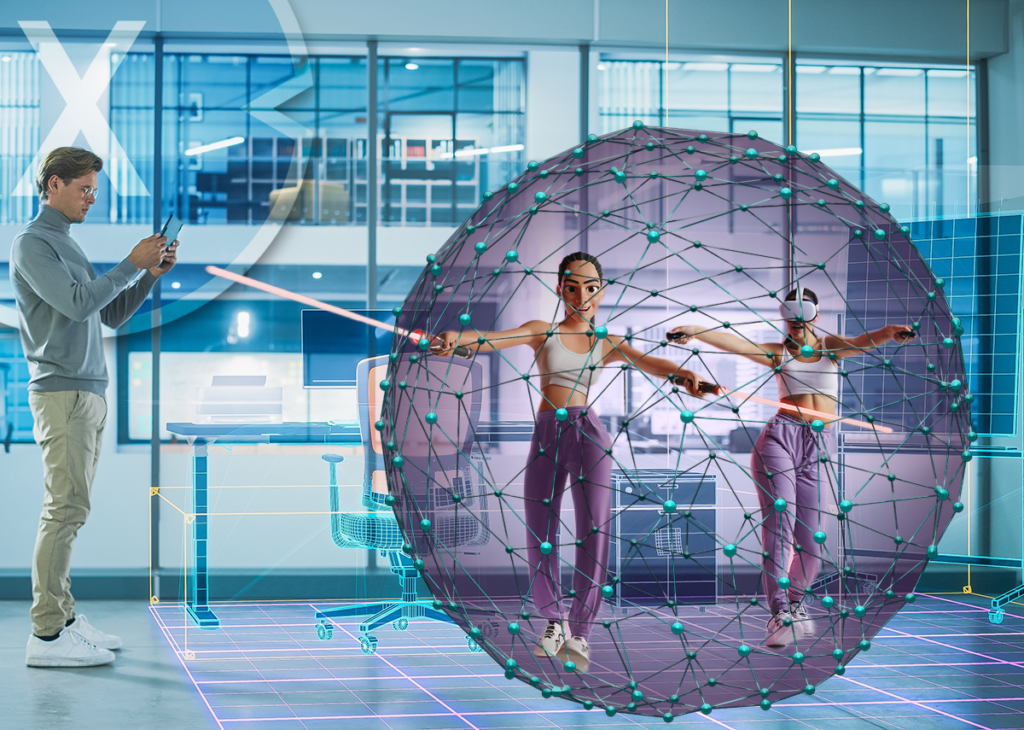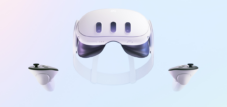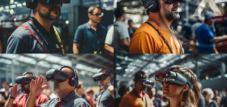Extended Reality Headsets: Technical differences between the various virtual and mixed reality glasses for various areas of application
Language selection 📢
Published on: September 15, 2024 / update from: September 15, 2024 - Author: Konrad Wolfenstein

Extended Reality Headsets: Technical differences between the various mixed reality glasses – creative image: Xpert.Digital
👓 Limitless possibilities: How extended and mixed reality are changing the world
🕶🌐⚙️ Extended, virtual and mixed reality glasses have undergone rapid development in recent years and are becoming increasingly popular, both in the private and business sectors. Companies worldwide are recognizing the potential of this technology to create immersive experiences, whether in education, training, simulations or even entertainment. In this context, it is important to take a closer look at the different models and their technical specifications as well as the possible applications.
🚀 The technological advances in mixed reality glasses
Mixed reality glasses offer a bridge between the physical and digital worlds. They allow users to overlay digital elements on real environments. This is done through a combination of augmented reality (AR), in which digital information is projected onto real environments, and virtual reality (VR), in which completely virtual worlds are created.
The advancement of display technologies, sensors and processors has led to today's mixed reality glasses offering impressive visual displays, precise motion tracking and high computing power. One of the most important technical specifications that users should pay attention to is the resolution per eye. This determines the clarity and sharpness of the content presented. For example, the latest devices offer resolutions of up to 3,648 x 3,144 dpi, enabling an extremely clear and realistic viewing experience. However, other devices offer lower resolutions, which may make them less suitable for certain applications.
In addition to the resolution, the field of view is also a crucial factor. It indicates the width of the area that the user can see while wearing the glasses. Models with a larger field of view, such as 110 degrees, provide a more immersive experience because the user is less distracted by the edge of the display. This is particularly important in games or simulation applications where a wide field of view contributes to immersion.
🌟 Areas of application and advantages of mixed reality glasses
Mixed reality glasses offer a wide range of possible uses in different industries. Here are some examples:
1. Education and Training
Mixed reality glasses can be used in schools, universities and training centers to make learning more interactive and engaging. For example, a medical student can practice surgery in a virtual environment, while a mechanic can learn how to repair complex machines without the need for physical machines.
2. Industry and Manufacturing
In industry, mixed reality glasses can be used to optimize workflows and conduct training. For example, workers can wear glasses that show them how to assemble or maintain machines without the need for manuals or paper instructions.
3. Real Estate and Architecture
Architects and real estate developers can use mixed reality glasses to create realistic 3D models of buildings and walk through them virtually. This allows customers to view properties before they are built and make design changes in real time.
4. Healthcare
Doctors can use mixed reality glasses to simulate complex surgeries or treat patients by seeing superimposed information directly in the field of view. This can be particularly helpful during minimally invasive surgeries or when visualizing tumors and other abnormalities.
5. Entertainment and gaming
The entertainment and gaming sector is one of the biggest beneficiaries of mixed reality technology. Game developers create immersive worlds where players can fully immerse themselves in the action. Additionally, mixed reality allows players to interact with their real-world surroundings while simultaneously immersing themselves in a digital world.
🔍 Important technical characteristics that should be taken into account when purchasing
When choosing mixed reality glasses, there are several important technical aspects that should be considered. In addition to the resolution and field of view that we have already mentioned, the following factors also play an important role:
Audio quality
Many mixed reality glasses are equipped with integrated speakers and microphones to improve interaction with the virtual environment. High-quality audio features can significantly improve the immersive experience, especially in areas such as gaming or simulations. For example, some devices offer built-in headphones with multiple microphones to ensure clear communication and noise cancellation.
Battery life
Battery life is another important aspect that is often overlooked by potential buyers. Depending on the application, longer battery life can be crucial, especially in industry where the glasses need to be used for extended periods of time. Models currently offer runtimes between two and three hours, which is sufficient for many applications but may not be enough for more intensive tasks.
Value for money
Prices for mixed reality glasses vary greatly, from around 500 euros to several thousand euros. Here it is important to keep an eye on the price-performance ratio. More expensive models usually offer better technical specifications, but it is not always necessary to choose the most expensive model if it is only used for basic applications.
🚧 Future developments and challenges
Despite the impressive advances in mixed reality technology, manufacturers continue to face some challenges. One of them is the weight and comfort of the glasses. Many users report that they experience discomfort after using the devices for a long time, especially in the neck and head areas. Manufacturers are working to develop lighter and more ergonomic designs to make them more comfortable to use for longer periods of time.
Another big issue is interoperability between different platforms and applications. Currently, it is often difficult to share mixed reality content between different devices and software solutions. It is expected that future developments will move towards standardized protocols and interfaces to improve compatibility between different devices.
The integration of artificial intelligence (AI) into mixed reality glasses could also become a significant trend in the coming years. AI could be used to create virtual assistants that respond to user requests in real time, recognizing objects in the environment and providing useful information. This technology could be used in industry, for example, to give workers immediate instructions or detect errors when assembling machines.
Another exciting field is the development of wireless and cloud-based solutions for mixed reality glasses. Currently, many models still rely on local computing power, which limits performance. However, as 5G networks and cloud computing continue to develop, future mixed reality glasses could access external computing resources, enabling much higher performance and a more seamless user experience.
🎯 Variety of possible applications in a wide variety of industries
Mixed reality glasses offer a fascinating mix of physical and digital worlds and open up a variety of possible applications in a wide variety of industries. Whether in industry, healthcare, education or gaming – the possibilities are almost endless. While there are still some challenges to overcome, particularly around comfort and interoperability, the advances in technology are impressive.
For companies and individuals who want to invest in this technology, it is important to carefully analyze the different technical specifications of the devices and check which model best suits their needs. The future of mixed reality glasses looks promising, and it is only a matter of time before this technology becomes a permanent part of our everyday lives.
📣 Similar topics
- 🌟 Mixed reality glasses revolution
- 🎯 Future technologies in view: XR glasses
- 🕶️ Discover the world of mixed reality
- 🎮 Immersive experiences through XR glasses
- 🛠️ Mixed reality in industry: take advantage of the benefits
- 🏥 Future of healthcare with XR
- 🏠 Experience real estate with mixed reality
- 📚 Revolutionize education with XR
- 🤖 Technical highlights of the mixed reality glasses
- 🔮 Exploiting the potential of XR technology
#️⃣ Hashtags: #MixedReality #VirtualReality #TechnicalSpecs #Education #Entertainment
🗒️ Xpert.Digital: A pioneer in the field of extended and augmented reality

Find the right Metaverse agency and planning office such as a consulting firm - Image: Xpert.Digital
🗒️ Find the right Metaverse agency and planning office such as a consulting firm - search and search for top ten tips for consulting & planning
In the age of digitalization, where technologies such as Extended Reality (XR) and the Metaverse are constantly becoming more relevant, Xpert.Digital positions itself as an opinion leader and pioneer. With over 1,500 specialist articles, Xpert.Digital has established itself as a central point of contact for the industry.
🌌 Extended Reality (XR): The best of both worlds
Extended Reality is a collective term that includes virtual reality (VR), mixed reality (MR) and augmented reality (AR). Xpert.Digital is committed to creating immersive XR experiences that are both informative and entertaining.
- Interactive Experiences: XR allows users to immerse themselves in virtual worlds and interact with their surroundings in ways previously unimaginable.
- Education and Training: XR can be used for educational purposes to convey complex topics and concepts in an understandable and tangible way.
- Entertainment: Whether games, films or art – XR opens new horizons in digital entertainment.
🔮 Augmented Reality (AR): See the world through digital eyes
Augmented Reality, a particular focus of Xpert.Digital, makes it possible to integrate digital information or graphics into the real world. The possibilities are nearly unlimited.
- Marketing and Advertising: AR can be used to create interactive advertising campaigns that engage customers in a whole new way.
- Everyday help: From navigation apps that project the route directly onto the street to furniture apps that show what a new sofa would look like in the living room - AR makes it possible.
🌐 The Metaverse: The Next Big Thing
The Metaverse is a virtual world where people can interact through avatars and create shared experiences. Xpert.Digital recognizes the enormous potential of the Metaverse and is working to translate this potential into usable products and services.
- Social Interaction: The Metaverse offers the opportunity to connect with people from all over the world and share common experiences.
- Economy and trade: Virtual goods and services can be traded in the metaverse, which opens up completely new business models and sources of income.
- Creative Freedom: From building your own worlds to designing custom avatars, the Metaverse is a place of endless creative possibilities.
🚀 Xpert.Digital at the forefront of innovation
Xpert.Digital shows how a company can be at the forefront of the technological revolution. With their focus on XR, AR and the Metaverse, they are well positioned to shape and define the future of digital interaction.
More about it here:
👓 Technical highlights of the mixed reality glasses
🕶️ The technical data of the various mixed reality glasses provide valuable information about the performance and areas of application of these devices.
1. 📊 Resolution per eye (dpi)
The resolution of the displays is a crucial criterion for the quality of the visual representation. Higher resolutions provide sharper and more detailed images, which is particularly relevant in applications with high visual requirements, such as in medicine or design.
Apple Vision Pro
With an impressive resolution of 3,648 x 3,144 dpi per eye, this model offers the sharpest image compared to the other devices. This resolution is ideal for applications that require extremely detailed visual feedback, such as complex design processes or high-end gaming.
Vive XR Elite (HTC)
The resolution of 1,920 x 1,920 dpi per eye is in the middle range. While it doesn't match the sharpness of the Vision Pro, it still offers good visual quality for most mixed reality applications. It is well suited for use in industry, education or moderate gaming applications.
ThinkReality VRX (Lenovo)
With 2,280 x 2,280 dpi per eye, Lenovo offers a relatively high resolution that is also suitable for demanding applications. The ThinkReality VRX could be an attractive model for professional environments that use both augmented reality (AR) and virtual reality (VR).
Quest 3 (Meta)
The Quest 3 has a resolution of 2,064 x 2,208 dpi per eye, making it a very balanced choice. The Meta devices are often known for gaming and social applications, but this resolution shows that they are also well suited for professional and creative uses.
HoloLens 2 (Microsoft)
With a resolution of 2,048 x 1,080 dpi per eye, the HoloLens 2 offers lower sharpness compared to other models. Nevertheless, Microsoft's focus on AR environments, such as in industry or medicine, is strong. The lower resolution is compensated for by the special software integration and precision of the environment tracking.
4 Enterprise (Pico)
The Pico glasses offer a resolution of 2,160 x 2,160 dpi per eye, which enables high image quality. Pico is often aimed at companies that use mixed reality solutions for training and industrial applications, and this resolution supports these uses well.
2. 👁️ Field of view distance
Field of view is another critical feature as it affects the level of immersion. A larger field of view results in the user becoming more immersed in the virtual environment as they see more of the simulated world.
VisionPro (Apple)
At approximately 100 degrees, the Vision Pro offers a wide field of view that is sufficient for most applications. The combination of high resolution and a solid field of view makes this model ideal for immersive experiences in the digital world.
Vive XR Elite (HTC)
Here HTC offers a wide 110-degree field of view, which is particularly advantageous for gaming and simulations as the user can immerse himself deeper in the virtual world.
ThinkReality VRX (Lenovo)
The field of view of approximately 95 degrees is at the lower end of the spectrum. This width might be a little limiting for some more immersive experiences, but is sufficient for business use where precision and clarity are more important than full immersion.
Quest 3 (Meta)
At approximately 110 degrees, the Quest 3 has the widest field of vision compared to many other glasses. This large field of view adds to the appeal of this device in gaming as it increases immersion and allows the user to delve deeper into the virtual world.
HoloLens 2 (Microsoft)
Microsoft does not provide any official information about the field of view width, but reports suggest that the field of view is smaller than on other devices. This could be a minor disadvantage in industrial applications where a wide field of view could be helpful.
4 Enterprise (Pico)
At approximately 105 degrees, Pico offers a wide field of view that is more than sufficient for most professional applications. This enables better spatial awareness and expands possibilities in industrial and business applications.
3. 🔊 Audio and microphones
Integrated audio and microphone solutions are particularly important for immersive applications where the user must interact with the virtual or augmented environment. Clear and precise sound is crucial for a complete experience.
Apple Vision Pro
The model offers integrated headphones and six microphones. This configuration is ideal for clear communication and noise cancellation, which is particularly beneficial in professional meetings or multiplayer gaming scenarios.
Vive XR Elite (HTC)
There are integrated headphones and two microphones, which offers solid audio quality. This configuration is sufficient for most users who want immersive experiences.
ThinkReality VRX (Lenovo)
Similar to the HTC model, the ThinkReality VRX also offers integrated headphones and two microphones. These are ideal for business meetings and collaborative AR applications.
Quest 3 (Meta)
With headphones and an integrated microphone, the Quest 3 is in the lower range. While the setup is sufficient for many recreational applications, it might be somewhat limited for professional or collaborative applications where clear communication is crucial.
HoloLens 2 (Microsoft)
Microsoft relies on headphones and five microphones, which is particularly useful in environments with background noise. The high number of microphones enables more precise speech recognition and improves the user experience in AR environments.
4 Enterprise (Pico)
With headphones and two microphones, Pico offers good equipment for clear communication and immersive experiences. This configuration is sufficient for most business applications.
4. 🔋 Battery life
Battery life plays an important role, especially in professional applications where the glasses need to be used for longer periods of time.
VisionPro (Apple)
The battery life is 2 to 2.5 hours, which can be sufficient for many professional and personal applications. However, this could limit longer sessions, such as industrial training or in-depth meetings.
Vive XR Elite (HTC)
Approximately 2 hours of run time provides a similar experience to the Vision Pro. For more intensive applications that take several hours, this could be a limiting factor.
ThinkReality VRX (Lenovo)
There is no official information about battery life. This could indicate that Lenovo is relying on removable or external power sources that offer more flexibility.
Quest 3 (Meta)
The battery life is 2 to 3 hours, making it a flexible choice for various applications, especially in the leisure sector where sessions tend to be shorter.
HoloLens 2 (Microsoft)
The running time is also 2 to 3 hours, which is sufficient in most cases for industrial and medical applications.
4 Enterprise (Pico)
Again, the runtime is 2 to 3 hours, which works well for many business applications, especially training and short presentations.
🚀 The choice of device depends largely on individual needs, applications and budget
The technical differences between the various mixed reality glasses offer specific advantages for different user groups. While the Apple Vision Pro scores with outstanding resolution and audio quality, the Meta Quest 3 is a balanced and inexpensive model for the consumer market. For business users, the ThinkReality VRX and HoloLens 2 offer robust solutions, especially for industrial and professional applications. Ultimately, the choice of device depends heavily on individual needs, applications and budget.
📣 Similar topics
- 🕶️ The best mixed reality glasses in comparison
- 🔍 Technical specifications of the leading mixed reality glasses
- 📊 Specifications and differences of MR glasses
- 🥽 Mixed reality glasses: resolution, field of view and more
- 🎧 Audio and microphone quality of the MR glasses
- 🔋 Battery life and energy efficiency of the mixed reality glasses
- 🏆 Top brands in comparison: Apple, HTC, Lenovo, and more
- 🌐 VR and AR: The best options for different use cases
- 👓 High-resolution mixed reality experiences
- 📅 Future of mixed reality: A technical outlook
#️⃣ Hashtags: #MixedReality #TechnologicalComparison #VRGoggles #ARTechnology #TechnicalSpecifications
We are there for you - advice - planning - implementation - project management
Xpert.Digital - Pioneer Business Development
Smart Glasses & KI - XR/AR/VR/MR industry expert
Consumer metaverse or meta -verse in general
If you have any questions, further information and advice, please feel free to contact me at any time.
I would be happy to serve as your personal advisor.
You can contact me by filling out the contact form below or simply call me on +49 89 89 674 804 (Munich) .
I'm looking forward to our joint project.
Xpert.Digital - Konrad Wolfenstein
Xpert.Digital is a hub for industry with a focus on digitalization, mechanical engineering, logistics/intralogistics and photovoltaics.
With our 360° business development solution, we support well-known companies from new business to after sales.
Market intelligence, smarketing, marketing automation, content development, PR, mail campaigns, personalized social media and lead nurturing are part of our digital tools.
You can find out more at: www.xpert.digital - www.xpert.solar - www.xpert.plus























